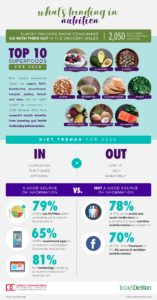National Survey of more than 2,000 Dietitians Reveals Movement Toward Clean, Natural and Simple with Surprising Predictions for Superfoods in 2018
In its sixth year, with a record-breaking 2,050 registered dietitian nutritionists (RDNs) responding, the Pollock Communications and Today’s Dietitian’s “What’s Trending in Nutrition” national survey once again exposes what RDNs predict consumers are thinking and eating. In a surprising switch, fermented foods – like yogurt, kefir, kombucha, sauerkraut, tempeh, some pickles, kimchi and miso – ousted seeds as the No. 1 superfood for 2018, making it clear that consumers will be “going with their gut” in the coming year by seeking out foods that improve gut health and overall well-being.
“RDNs stay ahead of the trends because they are dedicated to listening and responding to what consumers are looking for when making food choices,” explains Mara Honicker, publisher of Today’s Dietitian. “Our readers stay current on what consumers are thinking as much as they do nutritional science.”
Top 10 Superfoods for 2018
What’s changed for next year is the rise of “fermented foods” to the top spot. Surprising, but true, RDNs predict fermented foods will be highly sought by consumers in 2018. While widely known as the process used for making wine or beer, fermentation is a natural, metabolic process that involves using sugar to create compounds like organic acids, alcohols and gases. Fermented foods may have powerful health benefits from boosting gut health to blunting inflammation. The rest of the rankings included:
| 1. Fermented foods, like yogurt
2. Avocado 3. Seeds 4. Nuts 5. Green tea
|
6. Ancient grains
7. Kale 8. Exotic fruits 9. Coconut products 10. Salmon |
The Future is Here
In 2012, “What’s Trending in Nutrition”predicted that consumers would move toward “natural, less processed foods” (according to 72% of respondents). This national sample of RDNs forecasted that consumers were trending toward “simple ingredients” and a greater focus on “plants.” Move forward to today, and their projections have come to fruition as top diets for 2018. Coined, “clean eating” and “plant-based diets,” consumers are demanding foods and products that fit this way of life.
Diets Over Time
After “clean eating” and “plant-based diets,” first-timer, the “ketogenic diet” has made its way to the top as No. 3. This high-fat, generous-protein, barely-any-carb diet designed to produce ketone bodies for energy debuted with a high ranking. Interestingly, in 2013, RDNs felt that the trend in the “low carb diet” had declined. Then a year later, there was a rise in Paleo, Wheat Belly and Gluten-Free. Now, RDNs rank “Wheat Belly” as one of the diets on its way out and ketogenic has overtaken Paleo. Given the popularity of the high-fat ketogenic diet, it makes sense that the “low fat” diet was also ranked as a has-been.
“The movement toward clean eating reflects a change in how consumers view food,” notes Jenna A. Bell, PhD, RD, SVP of Pollock Communications. “Consumers are searching for nutrition information and equating diet with overall well-being.” As an example, Bell points out that the quick rise of fermented foods in the top 10 superfood list shows that consumers have expanded their definition of wellness to include benefits like gut health. “It also suggests that consumers are digging deeper for information about the food they eat and in this instance, finding out why yogurt, kefir or kimchi is so good for them!”
Fake News?
Over the years, the “What’s Trending in Nutrition” survey has captured the RDN perspective on where, how and from whom, consumers are getting their nutrition advice – good and bad. Since 2013, RDNs have acknowledged the power of social media, blogs, websites and celebs on nutrition decisions and the dissemination of misinformation. In 2014, celebrity doctors made their mark in the minds of consumers and RDNs ranked them as a growing provider of nutrition info. In the upcoming year, RDNs take aim and name Facebook as the No. 1 source of nutrition misinformation for consumers, followed by websites and blogs/vlogs.
Through the Years, We All Will Be Together
RDNs continue to recognize that consumers rank taste, cost, convenience and healthfulness as most important in the supermarket. And, the RDN messages remain consistent: MyPlate is the gold standard for helping consumers eat right (79% use it to educate) and it’s best to make small changes, focus on the overall eating pattern (not a single food or nutrient) and make gradual shifts over time. The RDNs top recommendations for 2018 are to limit highly processed foods, increase fiber intake, keep a food journal and choose non-caloric beverages such as unsweetened tea or coffee.
continue to recognize that consumers rank taste, cost, convenience and healthfulness as most important in the supermarket. And, the RDN messages remain consistent: MyPlate is the gold standard for helping consumers eat right (79% use it to educate) and it’s best to make small changes, focus on the overall eating pattern (not a single food or nutrient) and make gradual shifts over time. The RDNs top recommendations for 2018 are to limit highly processed foods, increase fiber intake, keep a food journal and choose non-caloric beverages such as unsweetened tea or coffee.
“The annual forecast from the ‘What’s Trending in Nutrition’ national survey shows how consumers are driving change and leading the evolution of diet and nutrition trends,” explains Louise Pollock, President and founder of Pollock Communications. “As they do each year, the unique perspective of RDNs provides media, retailers and food manufacturers a view into the minds of consumers that can help inform their business.”